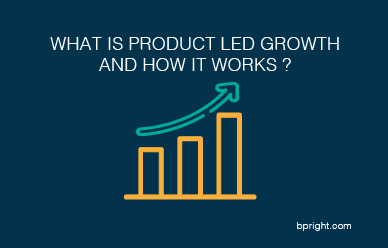Insights > Article Category > Sales & Marketing
What is Product-led growth (PLG) and how it works ?
BPRIGHT, Oct 28, 2022

Whether you’re starting a new product, software or changing an existing sales strategy,
product-led growth can assist you develop your customer base and keep costs down by focusing on one key rule: USERS SATISFACTION.
In this article, you’ll learn what product-led growth is, how it works, and why it’s worth doing.
What is product-led growth?
Product-led growth (PLG) is a commercialization strategy that considers the product as the best way to attract and retain users.
Product-led growth is accomplished by optimizing the customer experience (UX)—making it simple for clients to sign up, rapidly get an idea of the product,
its value, accomplish their work and share their positive experience with others, fueling word-of-mouth development.
A product-led growth approach isn’t the only way to bring in new customers, you can certainly use other client acquisition strategies like direct sales or marketing campaigns.
The key part of PLG essentially implies that more growth is driven by the product—and subsequently how clients associated with it than by anything else.
Why is product-led growth important?
Compared to alternative growth methods (sales- or marketing-driven approach), product-led growth has a number of business advantages, such as:
• Lower customer acquisition costs: Attracting new clients is simple since word-of-mouth recommendations make up the majority of customer growth.
• Higher retention, lower churn: Product-led growth often result in less-than-average churn rates when products are made to offer users direct and ongoing value.
• Higher revenue per employee: PLG companies can generate significant recurring revenue with few employees simply by relying on self-service sales and assistance.
• Higher Customer Satisfaction: Product-led businesses achieve high customer satisfaction by spending more time analyzing user data and improving UX, which turns customers into supporters and fuels word-of-mouth sales.
• Creative decision-making: Product-led growth compels traditional decision-makers to broaden the decision-making process to include different stakeholders.
This results in more creative ideas and business decisions that involve the product, technical, and support teams.
This still doesn't imply that product teams would be in charge of everything, but make them responsible for ensuring that all business stakeholders are aware of what is going on with the product by decentralizing product data and sharing information with them by forming cross-functional collaboration teams.
Who can use product-led growth?
The majority of product-led growth occurs in the digital or SaaS (software-as-a-service) industries, however it may not be appropriate for all online businesses or products.
The major requirements a business must fulfill to succeed with PLG are:
1. Serve a large market with your product
2. Transparent and affordable prices
3. Free trial (Freemium plan)
4. low-cost advertising methods like word-of-mouth, content marketing, or PPC.
5. A product with a wide range of value propositions and a very short time to value

5 methods to drive product-led growth
Here are five effective strategies to start incorporating product-led growth into your workflow right away,
supposing your product already satisfies the fundamental PLG characteristics (mass market, freemium, self-service, simplicity):
1. Improve the enrolment experience
In a product-led strategy, customers must instantly see the value of a product because it is the customer
onboarding process that will encourage them to register or continue further than a free trial.
You could achieve this by identifying the issues users often get stuck on while interacting with your product,
and put a fix in place that will reduce onboarding process complexity and barriers, boosting time to value.
2. Improve the purchase experience
Self-service purchasing is a significant contributor to product-led growth,
considering that it is quick and scales without the need for more sales or customer success teams.
You may improve sign-ups and reduce complexity in the customer journey by optimizing your landing pages
with the use of conversion rate optimization (CRO).
3. Understand your users’ selection process
The reasons why your product was chosen and the duties your product is expected to perform will help you concentrate
on optimizing and delivering features that directly address your clients’ challenges.
Simply ask your clients directly to learn why they acquired your product.
After a successful sign-up, you can start a survey to find out what problems users encountered before choosing to use your product.
4. How Shareable is your product
Product ability to be shared easily is vital for product-driven businesses since it drives word-of-mouth sales,
even if a product isn't particularly shareable on its own, you can still incorporate a sharing thread into the
experience to generate momentum.
5. Company-wide product insights communication
Product analytics must be shared to all parties in order to maintain the product at the center
of decision-making because PLG organizations typically have a larger range of stakeholders than traditional ones.
Implementing product-led growth
The easiest place to start is by focusing attention on your users, whether you already work for a product-led company or
simply want to include more product-led growth into your strategy.
The first step in improving their product experience is to understand how they use it, what bugs them, and what makes them happy.
Contact us today if you need business growth insights and strategies.



